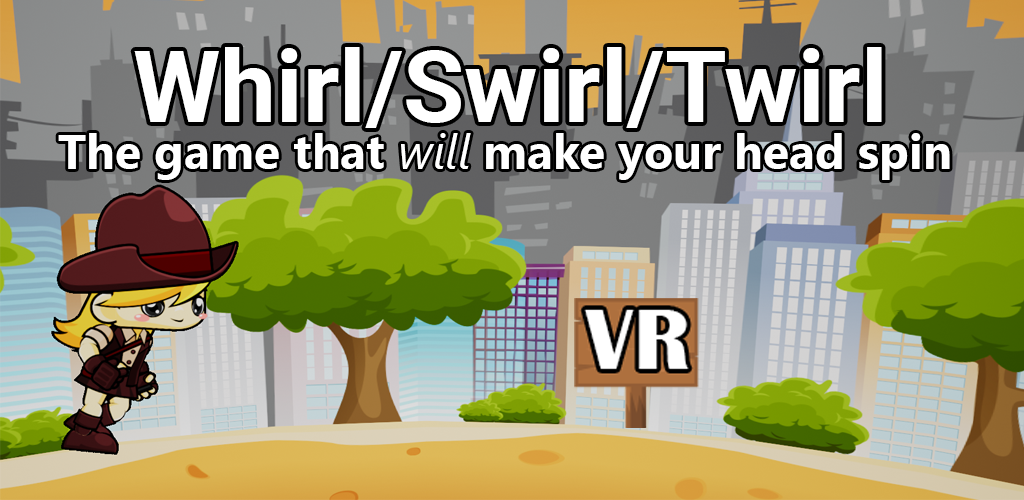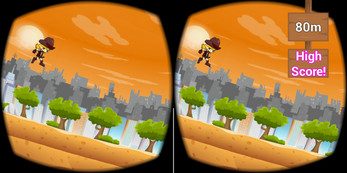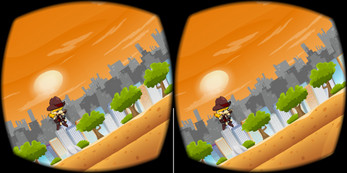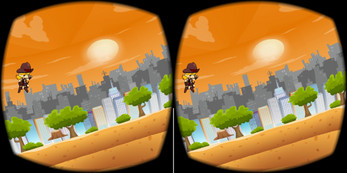
Whirl/Swirl/Twirl VR
A downloadable game for Android
Embark on a literal head-spinning adventure by helping a brave explorer navigate through the falling obstacles with nothing but your balance and coordination. Spin around as you try to keep up even though she'll definitely be running circles around you!
Control the game by spinning around to follow the character, lively titling your head to the left to jump and tilting it to the right to fall down faster. Navigate through the menus with your gaze. The rest is up to you - and your balance! Just don't forget to whirl. Or swirl. Or, alternatively, twirl.
This evergreen endless runner fun with a VR twist is compatible with all mobile virtual reality headsets based on the Google Cardboard platform, including 3rd party goggles - so just make sure you're in a safe environment (preferably with someone to assist you) and get down to spinning!
| Status | Released |
| Platforms | Android |
| Rating | Rated 5.0 out of 5 stars (1 total ratings) |
| Author | Katspybara |
| Genre | Adventure, Platformer |
| Tags | 2D, Casual, Colorful, Cute, Female Protagonist, Singleplayer, Virtual Reality (VR) |
Download
Click download now to get access to the following files:





Comments
Log in with itch.io to leave a comment.
Nice, it's always cool to find 2D virtual reality games (it's my favorite niche).
I really like the music.
I'm also curious how long you spent on this and how many features didn't make the final cut.
I also like how you used gesture controls (did you set up a controller and realize there's too many controller variants to reasonably support them all?).
Good luck with your future projects and well done on this one.
Thanks a lot! Sorry for the late reply but we've got some crazy times going on around and it flew under my radar :)
Hah, this is a story in and of itself! :D The first prototype of this (not using gaze pointers or head gestures yet - everything was controlled with a bluetooth remote) I developed as a proof of concept used for my Master's thesis about the problem of 2D game worlds representation in VR, back in 2017. At first, I had some plans to finish it cause I liked the idea, too, but later of course a hundred different things came my way and there was always something else to do - and motivation to continue with this project was hard to find.
Throughout these years, I sometimes came back to the project to get myself accustomed again with the scripts and get into the groove, only to leave it again after a few days. Thus, the total number of days spent on this from 2018 to 2020 was probably around six, haha!
In the end, around late October 2019 I finally decided to get my shit together and finish this thing until the end of November. Which then became December. And January. AND FREAKING FEBRUARY. Unsurprisingly, I hit all the cliche problems and mindset traps of an indie: "It's just a small game, why waste time on it?", "Aaahh I don't feel like doing it today" (which then became "this week" and "this month" of course), "OMG fixing this bug is so boring, maybe let's just scrap this thing altogether", the whole package ;)
So even though I'd really like to answer your question, I have no idea in the world how much time it took! On paper? Around three years :D Actual workload though? I'd say a month of honest work for the prototype, documentation and the thesis in 2017, then a day or two thinking about the design here and there throughout 2018 and 2019, then about a week or two of actual work in late 2019 and the same amount in 2020. Two months of actual work would be my ballpark figure then, I guess? 100% margin of error though, haha!
As for the controls, like I said the controllers were actually the first thing that was supported but I decided to drop the support for it when releasing it for the market so as not to make a niche market even more niche because of the need for Cardboard as well as an external controller. There are still a lot of leftovers from that code so I guess it wouldn't even be that hard to make it work again - and certainly there wouldn't be a need to start from scratch for that!
As for the features that did not make it, there were not that many to be frank! Most of them were presentational (better and more fluid animations for the distance info, clearer way of presenting data during gameplay), better control of jump height, trying to do something with parallax instead of flat background (which I dropped partly because I wanted to finally get it over with and partly because this seemed like too much of a nausea hazard when combined with the constant spinning) and kind of a in-between state before starting the run so that you're not thrown immediately into action but rather have come countdown to get ready after choosing "Start". Nothing major though, like you see!
Thanks for your input, all the best to you too! :)
Thank you for the super detailed answer. I know that feeling where you've worked on something for 3 years but was only 2 months of work (and it's super relatable).
Is it possible you could link/send me your master's thesis? I haven't found a research paper on "2D virtual reality" concepts yet, and your paper may be the first out there (especially since it was written in 2017).
I'm also curious how you were implementing parallax (I personally thought it was mostly impossible for consistent 360 degree worlds, but I definitely thought about it less than you, and also other developers I talked to thought it was possible).
The stuff about controllers is super relatable:
"virtual reality" (niche) > "2D virtual reality" (niche in niche) > "phone-based 2D virtual reality with a particular bluetooth controller" (niche-ception)
That one's gonna be problematic :D And the reason for that is, I wrote it in my native language which is Polish and it's not translated so I doubt it'll be of any use to you regretfully :( But as for it being the first/among the first ones, that is true - when I was writing it, I could not find anything on 2D VR either, be it in English or Polish :)
I did not get to actual implementation cause I did not want to get caught up into the never ending loop of "one more feature" again and honestly just wanted to finally release the game cause the total timeframe started looking a bit embarrasing :) But as for how I imagined it, I though of it in such a way: when you imagine your 2D VR world as kind of being inside a sphere or a cylinder (which are by far two of the best ways of implementing 2D world in VR, both for their own reasons), all you see around you reacts to your head movements like real life would, ie. you turn left -> you see what is currently projected on that region of the sphere/cylinder.Now, to implement parallax, we could create a secondary container like our first one, say a cylinder inside our "main" cylinder, which would only hold the things on that layer of the parallax, but instead of reacting 1:1 to your head movements, it actually _counters_ the movement - ie. you look to the right, you see what is on the right of your position in your "main" cylinder, but the -1st layer actually spins a bit to the left with each offset you turn right. And the -2nd layer counters the rotation of your head even more to the opposite direction. And so on, and so forth.
Don't know if my descriptions actually make sense cause this explanation begs for using your hands while talking about it to show how these layers intertwine :D But another helpful way to think of it if that's confusing would be to image a flat parallax with its layers and then glue together the shorter ends + instead of having it counter the movement of the camera, having it counter the movement of the _head_ of the player.
Of course we'd also need separate sets of rules for each layer (eg. some of them only reacting to yaw movements or only to pitch, so that they don't all naively follow or counter your vision) but these wouldn't be so hard to implement! This would require some heavy playtesting of course, though, cause this sounds like a proper nauseatorium :D
Haha, tell me about it!Even if the paper is in Polish, I would still love to read it (with the help of Google Translate) and look at the pictures if there are any. If I were new to the subject I would probably be doomed at reading it, but since I have a background in 2D virtual reality, I can probably benefit from it even if I misinterpret some of the text. Also, I haven't checked on the academic portals yet, but I wouldn't be surprised if your paper was still the only one about 2D virtual reality in 2020.
That being said, if it's a hassle to send (with or without a paid link) then you shouldn't go out of your way if you don't have much time. (The same goes for replies here since we're all busy.)
Re: parallax
Your description of parallax makes sense to me (especially for the cylinder version). I should definitely think about it further, because it would be a shame to miss a cool feature over my own ignorance. Additionally, you can definitely do parallax for games that exist in an xy-plane but are rendered in virtual reality.
The analogy I would use is a large semi-transparent square cloth representing the world map and a smaller spherical light bulb that represents what the player can see at any given moment. The light bulb projects a subset of the world map on the walls. This system works relatively well without much stretching of the cloth for a <=180 degree field-of-view. In this system you could basically do parallax the same as traditional 2D games (with different layers moving at different speeds in the xy-plane).
And nausea is ironically a huge issue in 2D virtual reality in my experience (it was counter-intuitive to me at least). I don't think it's an inherent problem, it's just hard to design 2D virtual reality games (at least for now).
Hey there I work with SideQuest at https://sidequestvr.com/#/ , i just wanted to ask if you had considered us as a place to post your game to reach more people in VR. If you would be interested in putting it on SideQuest We would love to have your game on us as our goal is to help host and distribute games in as easy a manner as possible for both developers and users, If you ever want to sell a game you create you can even link the SideQuest listing directly to Itch.io so people can easily buy your game on Itch.io and install through us. Listing any game on SideQuest is also completely free to set up and use. If you're interested at all any time in the future and want to know more there's more information about SideQuest like on how to submit an application or game here: https://github.com/the-expanse/SideQuest/wiki/How-To-Submit-Games and an example of a listing currently on us using Itch integration you can see here: https://sidequestvr.com/#/app/358 in any case best wishes and we hope for the brightest of futures for you.